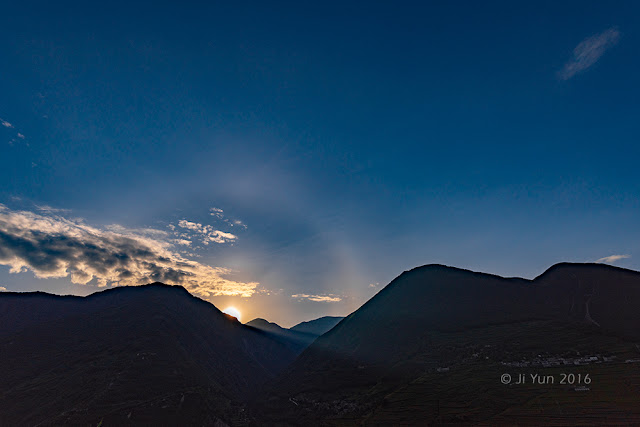When I first noticed the display at 08-10 local time on 31 May 2018, it was already well-developed. The high cloud layer was very thin and it was visible only in the area close to the sun. At first the display consisted of an upper 23d plate arc and an upper quarter of a 23d halo. A little later I noticed arcs as light spots in the side area of the sun, that reminded me lower 24d plate arcs.
When I processed images, I noticed that these arcs are more like 18d plate arcs than lower 24d plate arcs. But during the observation I distinctly saw that the arcs were located at an elevation lower than the sun, while 18d plate arcs are always located at the same elevation as the sun. I applied stronger processing and revealed a gap between the arcs and a 18d halo. As a result, it became clear that the arcs are exotic 19d plate arcs that were first observed during the legendary Lascar display. In addition, a trace of exotic 28d halo was also revealed.
Some analysis
The halos, known as Lascar halos, are caused by exotic pyramidal crystals with pyramidal faces of (2 0 2 3) Miller index. These exotic pyramids have a 39.1 apex angle while pyramids from regular pyramidal crystals have a 56.1 angle. To simulate the display, I used four different crystal populations. Not one of them have basal crystal faces. The first population is plate oriented pyramidal crystals with upper exotic and lower regular pyramidal faces. This population makes most visible features of the display (19d and 23d plate arcs). The second population consists of crystals with regular upper and lower pyramids, and it contributes to 18d and 23d halos. The population is poorly oriented, in order to reproduce some features of 18d and 23d halos. The third population contains plate oriented regular pyramidal crystals consisting only of lower pyramidal faces. It needs only to enhance the upper 23d plate arc. Finally, the fourth population is added to reproduce the 28d halo. Its crystals is randomly oriented and consists of upper exotic pyramidal faces in triangular habit. That is, the crystals are almost regular tetrahedrons.
The result shows quite good agreement with the observation, except for an exotic lower 3d plate arc. There are two possible reasons for it. The first is that a glow around the sun has much more intensity than halos presented here. It does not allow to reveal a 3d arc, unlike the Lascar display, whose observing place was located at an altitude more than of 4000 m above sea level. At this altitude the atmosphere has a low level of aerosols, and therefore the glow around the sun is very small, and the sky background is dark. My observation point was in Pskov Oblast, which has a flat topography with usual atmospheric conditions. The second reason is that exotic crystals may have triangular, but not hexagonal habit. The 3d arc disappears when triangular exotic crystals are applied.
References
- Nicolas A. Lefaudeux, "Crystals of hexagonal ice with (2 0 2 3) Miller index faces explain exotic arcs in the Lascar halo display"
- Nicolas A. Lefaudeux (personal communication, 2018)
When I processed images, I noticed that these arcs are more like 18d plate arcs than lower 24d plate arcs. But during the observation I distinctly saw that the arcs were located at an elevation lower than the sun, while 18d plate arcs are always located at the same elevation as the sun. I applied stronger processing and revealed a gap between the arcs and a 18d halo. As a result, it became clear that the arcs are exotic 19d plate arcs that were first observed during the legendary Lascar display. In addition, a trace of exotic 28d halo was also revealed.
 |
| Sun elevation is about 36 degrees |
Some analysis
The halos, known as Lascar halos, are caused by exotic pyramidal crystals with pyramidal faces of (2 0 2 3) Miller index. These exotic pyramids have a 39.1 apex angle while pyramids from regular pyramidal crystals have a 56.1 angle. To simulate the display, I used four different crystal populations. Not one of them have basal crystal faces. The first population is plate oriented pyramidal crystals with upper exotic and lower regular pyramidal faces. This population makes most visible features of the display (19d and 23d plate arcs). The second population consists of crystals with regular upper and lower pyramids, and it contributes to 18d and 23d halos. The population is poorly oriented, in order to reproduce some features of 18d and 23d halos. The third population contains plate oriented regular pyramidal crystals consisting only of lower pyramidal faces. It needs only to enhance the upper 23d plate arc. Finally, the fourth population is added to reproduce the 28d halo. Its crystals is randomly oriented and consists of upper exotic pyramidal faces in triangular habit. That is, the crystals are almost regular tetrahedrons.
 |
My attempt to simulate the display.
Software: HaloPoint 2.0 by Jukka Ruoskanen
|
References
- Nicolas A. Lefaudeux, "Crystals of hexagonal ice with (2 0 2 3) Miller index faces explain exotic arcs in the Lascar halo display"
- Nicolas A. Lefaudeux (personal communication, 2018)







